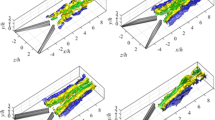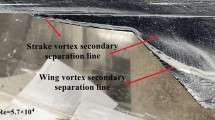Abstract
Accurate experimental characterization of longitudinal vortices induced by rectangular winglets is necessary to develop and validate numerical models that can predict these flows. For this aim, an experimental investigation is conducted to examine the characteristics of longitudinal vortices generated downstream rectangular winglets in fully developed turbulent channel flow. A row of rectangular winglet pairs is implemented in a parallel plate flow. Stereoscopic Particle Image Velocimetry (SPIV) is used to harvest three-dimensional (3D) instantaneous velocity fields for a Re = 4400 based on the channel’s hydraulic diameter and mean flow velocity. 3D velocity components, velocity streamlines, topologies of Γ2 function and normalized turbulent kinetic energy downstream the winglets are analyzed. It is shown that the flow properties are disturbed, and a main vortex pair is generated in addition to induced vortices downstream the rectangular winglets. Moreover, this work provides an SPIV benchmark of the complex flow developing downstream rectangular winglet pairs, where this configuration has been widley studied using numerical simulations.

Graphical Abstract
















Similar content being viewed by others
Abbreviations
- H :
-
Channel height, m
- X :
-
Longitudinal distance from VG trailing edge, m
- Y :
-
Transverse distance from channel mid-axis, m
- Z :
-
Vertical distance from channel bottom wall, m
- Re :
-
Reynolds number, dimensionless
- S :
-
Domain
- M :
-
Domain center
- U :
-
Mean flow velocity, m s−1
- u rms :
-
Rms velocity component, m s−1
- u :
-
Flow longitudinal velocity component, m s−1
- v :
-
Flow transverse velocity component, m s−1
- w :
-
Flow vertical velocity component, m s−1
- \( \overline{u},\overline{v},\overline{w} \) :
-
mean velocity components, m s−1
- u ′ , v ′ , w′ :
-
Turbulent Fluctuations, m s−1
- \( \overrightarrow{u_s} \) :
-
Velocity convection, m s−1
- \( \overrightarrow{u_m} \) :
-
Local velocity in a domain, m s−1
- y + :
-
Dimensionless wall distance
- U + :
-
Dimensionless mean velocity profile with wall shear velocity
- Γ1 :
-
Gamma-1 function
- Γ2 :
-
Gamma-2 function
- 2D-PIV:
-
2-Dimensional Particle Image Velocimetry
- 3D-PIV:
-
3-Dimensional Particle Image Velocimetry
- 3C-PIV:
-
3 Components Particle Image Velocimetry
- CCD:
-
Charge-coupled device
- CCW:
-
Counterclockwise
- CFD:
-
Computational Fluid Dynamics
- CW:
-
Clockwise
- DWP:
-
Delta Winglet Pair
- KEtot :
-
Total turbulent kinetic energy, J
- KEm :
-
Mean kinetic energy, J
- LDA:
-
Laser Doppler Anemometry
- LVG:
-
Longitudinal Vortex Generator
- Nd:YAG:
-
Neodymium-doped Yttrium Aluminum Garnet
- PIV:
-
Particle Image Velocimetry
- rms :
-
Root mean square
- RWP:
-
Rectangular Winglet Pair
- SPIV:
-
Stereoscopic Particle Image Velocimetry
- TKE:
-
Turbulent kinetic energy
- TVG:
-
Transverse Vortex Generator
- VG:
-
Vortex Generator
References
He S, Zhou X, Li F, Wu H, Chen Q, Lan Z (2019) Heat and mass transfer performance of wet air flowing around circular and elliptic tube in plate fin heat exchangers for air cooling. Heat Mass Transf 55:3661–3673
Du J, Qian Z-Q, Dai Z-y (2016) Experimental study and numerical simulation of flow and heat transfer performance on an offset plate-fin heat exchanger. Heat Mass Transf 1791–1806:52
Otović M, Mihailović M, Genić S, Milovančević BJU, Marković S (2018) Reconsideration of data and correlations for plate finned-tube heat exchangers. Heat Mass Transf 54:2987–2994
Ali S, Habchi C, Menanteau S, Lemenand T, Harion J (2017) Three-dimensional numerical study of heat transfer and mixing enhancement in a circular pipe using self-sustained oscillating flexible vorticity generators. Chem Eng Sci 162:152–174
Habchi C, Harion J (2014) Residence time distribution and heat transfer in circular pipe fitted with longitudinal rectangular wings. Int J Heat Mass Transf 74:13–24
Hamed A, Pagan-Vazquez A, Khovalyg D, Zhang Z, Chamorro L (2017) Vortical structures in the near wake of tabs with various geometries. J Fluid Mech 825:167–188
Ajakh A, Kestoras M, Toé R, Peerhossaini H (1999) Influence of forced perturbations in the stagnation region on Görtler instability. The American Institute of Aeronautics and Astronautics Journal 37:1572–1577
Habchi C, Lemenand T, Della Valle D, Peerhossaini H (2009) Liquid/liquid dispersion in a chaotic advection flow. Int J Multiphase Flow 35:485–497
Kwon HG, Hwang SD, Cho HH (2008) Flow and heat/mass transfer in a wavy duct with various corrugation angles in two dimensional flow regimes. Heat Mass Transf 45:157–165
Gretta W, Smith C (1993) The flow structure and statistics of a passive mixing tab. Transactions of the ASME, Journal of Fluids Engineering 115:255–263
Limaye MD, Vedula RP, Prabhu SV (2013) Comparison of heat transfer distributions on a flat plate impinged by under-expanded jets from a convergent nozzle and a circular orifice. Heat Mass Transf 49:309–326
Jacobi A, Shah R (1995) Heat transfer surface enhancement through the use of longitudinal vortices: a review of recent progress. Exp Thermal Fluid Sci 11:295–309
Khanjian A, Habchi C, Russeil S, Bougeard D, Lemenand T (2018) Effect of the angle of attack of a rectangular wing on the heat transfer enhancement in channel flow at low Reynolds number. Heat Mass Transf:1441–1452
Tiggelbeck S, Mitra N, Fiebig M (1994) Comparison of wing-type vortex generators for heat transfer enhacement in channel flows. J Heat Transf 116:880–885
Ghanem A, Habchi C, Lemenand T, Della Valle D, Peerhossaini H (2013) Energy efficiency in process industry - high-efficiency vortex (HEV) multifunctional heat exchanger. Renew Energy 56:96–104
Westphal RV, Mehta RD (1989) Interaction of an oscillating vortex with a turbulent boundary layer. Exp Fluids 7(6):405–411
Webb R, Kim N (1994) Principles of enhanced heat transfer. Wiley, New York
Zhang L, Meng BSH, Wang YLC, Wu BGJ (2017) Effects of the arrangement of triangle-winglet-pair vortex generators on heat transfer performance of the shell side of a double-pipe heat exchanger enhanced by helical fins. Heat Mass Transf:127–139
Chang SW, Lees AW, Chang H-T (2009) Influence of spiky twisted tape insert on thermal fluid performances of tubular air–water bubbly flow. Int J Therm Sci 48:2341–2354
Habchi C, Russeil S, Bougeard D, Harion JL, Lemenand T, Della Valle D, Peerhossaini H (2012) Enhancing heat transfer in vortex generator-type multifunctional heat exchangers. Appl Therm Eng 38:14–25
Vintrou S, Bougeard D, Russeil S, Nacereddine R, Harion J-L (2013) Quantitative infrared investigation of local heat transfer in a circular finned tube heat exchanger assembly. Int J Heat Fluid Flow 104:197–207
Habchi C, Lemenand T, Della Valle D, Peerhossaini H (2010) Turbulence behavior of artificially generated vorticity. J Turbul 11(36):1–28
Kwak K, Torii K, Nishino K (2002) Heat transfer and flow characteristics of fin-tube bundles with and without winglet-type vortex generators. Exp Fluids 33(5):696–702
Habchi C, Harion JL, Russeil S, Bougeard D, Hachem F, Elmarakbi A (2013) Chaotic mixing by longitudinal Vorticity. Chem Eng Sci 104:439–450
Kamboj R, Dhingra PS, Singh PG (2014) CFD simulation of heat transfer enhancement by plain and curved winglet type vortex generators with punched holes. International Journal of Engineering Research and General Science 2(4)
Zhou G, Feng Z (2014) Experimental investigations of heat transfer enhancement by plane and curved winglet type vortex generators with punched holes. Int J Therm Sci 78:26–35
Ünal UO, Atlar M (2010) An experimental investigation into the effect of vortex generators on the near-wake flow of a circular cylinder. Exp Fluids 48(6):1059–1079
Fiebig M (1995) Embedded vortices in internal flow: heat transfer and pressure loss enhancement. Int J Heat Fluid Flow 16:376–388
Fiebig M (1995) Vortex generators for compact heat exchangers. Journal of Enhanced Heat Transfer 2(1–2):43–61
Tian L, He Y, Lei Y (2009) Numerical study of fluid flow and heat transfer in a flat Plate Channel with longitudinal vortex generators by applying field synergy principle analysis. Int Commun Heat Mass Transfer 36(2):111–120
Lee S, Ryou H, Choi Y (1999) Heat transfer in a three dimensional turbulent boundary layer with longitudinal vortices. J Heat Transf 124:1521–1534
Biswas G, Torii K, Fujii D, Nishino K (1996) Numerical and experimental determination of flow structure and heat transfer effects of longitudinal vortices in a channel. Int J Heat Mass Transf 39(16):3441–3451
Sheng J, Meng H, Fox R (2000) A large eddy PIV method for turbulence dissipation rate estimation. Chem Eng Sci 55:4423–4434
Andreopoulos Y, Honkan A (1996) Experimental techniques for highly resolved measurements of rotation, strain, and dissipation rate tensors in turbulent flows. Meas Sci Technol 7:1462–1476
Hussein H, Martinuzzi R (1995) Energy balance for turbulence flow around a surface mounted cube placed in a channel. Phys Fluids 56:764–780
Wang B, Lee S, Ho K (2006) Chemical composition of fine particles from incense burning in a large environmental chamber. Atmos Environ 40:7858–7868
Dong D, Meng H (2004) Flow past a trapezoidal tab. J Fluid Mech 510:219–242
Štigler J (2012) Introduction of the analytical turbulent velocity profile between two parallel plates, in 148, Svratka, Czech Republic
Homlan J (2010) Heat transfer 10th edition. McGraw-Hill, New York
Prasad AK, Jensen K (1995) Scheimpflug stereocamera for particle image velocimetry in liquid flows. Appl Opt 34(30):7092–7099
Ali MS, Tariq A, Gandhi BK (2016) Role of chamfering angles and flow through slit on heat transfer augmentation behind a surface-mounted rib. J Heat Transf 138:111901
Sharma N, Tariq A, Mishra M (2018) Experimental investigation of flow structure due to truncated prismatic rib turbulators using particle image velocimetry. Exp Thermal Fluid Sci 91:479–508
Sciacchitano A (2019) Uncertainty quantification in particle image velocimetry. Meas Sci Technol 30(9):092001
Basu S (2018) Plant flow measurement and control handbook: fluid, solid, slurry and multiphase flow. Academic, Cambridge
Uzol O, Camci C (2001) The effect of sample size, turbulence intensity and the velocity field on the experimental accuracy of ensemble averaged PIV measurements. In: 4th international symposium on particle image velocimetry, Göttingen, Germany
Braza M, Perrin R, Hoarau Y (2006) Turbulence properties in the cylinder wake at high Reynolds numbers. J Fluids Struct 22:757–771
Depardon S, Lasserre J, Brizzi L, Boree J (2006) Instantaneous skin-friction pattern analysis using automated critical point detection on near-wall PIV data. Meas Sci Technol 17(7):1659–1669
Graftieaux L, Michard M, Grosjean N (2001) Combining PIV, POD and vortex identification algorithms for the study of unsteady turbulent swirling flows. Meas Sci Technol 12:1422–1429
Berson A, Michard M, Blanc-Benon P (2009) Vortex identification and tracking in unsteady flows. C R Mec 337:61–67
Favelier T, Michard M, Grosjean N (2004) Développement d'un critère d'identification de structures tourbillonnaires adapté aux mesures de vitesse par PIV. In: Proc. 9ème Congrès Francophone de Vélocimétrie Laser, Bruxelles
Acknowledgements
This work was partially funded by the ANR CarnotMINES “C.I.E.T.”. Authors would like to acknowledge Chrystèle Qaegeber-Evrard for her contribution in the experimental work.
Author information
Authors and Affiliations
Corresponding author
Additional information
Publisher’s note
Springer Nature remains neutral with regard to jurisdictional claims in published maps and institutional affiliations.
Rights and permissions
About this article
Cite this article
Oneissi, M., Bouhoubeiny, E., Russeil, S. et al. Experimental analysis by stereo-PIV of the development of streamwise vortices downstream of rectangular winglets. Heat Mass Transfer 56, 2487–2502 (2020). https://doi.org/10.1007/s00231-020-02874-1
Received:
Accepted:
Published:
Issue Date:
DOI: https://doi.org/10.1007/s00231-020-02874-1




